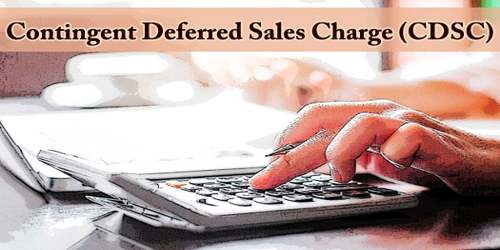Contingent Deferred Sales Charge (CDSC), also called a ‘back-end load’ or ‘sales charge’; it’s a fee, sales charge, or load, which mutual fund investors pay when selling Class-B fund shares within a specified number of years from the first purchase date. For mutual funds with share classes that determine when investors pay the fund’s load or sales charge, Class-B shares carry a contingent deferred sales charge during a five- to 10-year holding period calculated from the time of the initial investment. The financial industry usually expresses a CDSC as a percentage of the dollar amount invested into a mutual fund. Sometimes, the finance industry may confer with a CDSC as an exit fee or a redemption charge.
Some mutual funds charge contingent deferred sales charges when investors sell shares back to the fund. Some mutual funds charge these fees for returns of certain classes of shares, but not for others.
Before we invest in a mutual fund, it is important that we understand whether or not the fund will charge a contingent deferred sales charge when we sell our shares back to the fund. If this fee is charged, we should understand how high the charge is, as it represents a cost which will cut into potential capital gains.
Contingent deferred sales charges (CDSC) are commonly assessed on the start value of the investment, although some companies calculate the fee on the ending value if the share price is not up to the initial damage.
Let’s assume we make a $10,000 investment in the Company ABC mutual fund, which has a 4% back-end load. The presence of the contingent deferred sales charges means that the investor must pay a $400 fee upon the sale of the investment ($10,000 x .04). Ideally, the earnings from the investment should more than makeup for the contingent deferred sales charges. In this example, the fund must, therefore, return 14% in one year to reach $11,000 in value after the fee, but the no-load fund must only return 10% to do so.
Generally, an investment will reduce contingent deferred sales charges for each year the investor holds the security. If the investor holds the investment long enough, i.e., for the duration of the surrender period, many fund companies waive the back-end fee.
If a mutual fund investor were to buy and hold Class-B fund shares until the top of the required hold period, they may avoid paying this sort of fund’s sales charge, thereby enhancing their investment return. Unfortunately, fund research indicates that open-end investment company investors are holding their funds, on average, for fewer than five years, which regularly triggers the applying of a back-end sales charge in an exceedingly Class-B share fund investment.
Contingent deferred sales charges (CDSC) are not included in the total expense ratios (TERs) quoted by mutual funds, as they are a one-time cost. The TER only includes ongoing costs. When calculating the cost of investing in a fund, you must account for the front end load (if it has one) and the contingent deferred sales charge in addition to the TER. Possible custodial fees charged by a custodian bank for the safekeeping of our fund shares are another cost that should be accounted for.
Generally, contingent deferred sales charges (CDSC) are reduced for every year the investor holds the investment. If the investor holds the investment long enough, i.e. for the duration of the surrender period, many fund companies waive the back-end fee. For instance, a contingent deferred sales charge could be 5% within the first year, 4% within the second year, and then forth until the fee is zero. Additionally, some fund companies automatically convert B shares to A shares after the surrender period.
CDSCs tend to discourage investors from actively trading mutual fund shares, which might require mutual funds to stay significant levels of liquid cash readily available. Many consider the CDSC to be a payment for the broker’s expertise in choosing an investment company that matches an investor’s goals. On prospectuses, mutual funds must disclose CDSC and other fees, so investors may evaluate all costs related to an investment together with other investor-specific factors like risk tolerance and time horizon.
Information Sources:
















